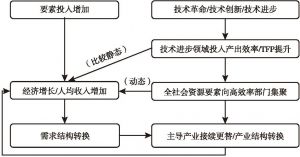摘要
以互联网、大数据、人工智能等为代表的新一代信息与通信技术(New Generation of Information and Communication Technology,NGIT),代表了新一轮科技革命(第六次技术革命)与产业变革趋势下科技和经济发展的主流方向。NGIT与实体经济的融合,最终将体现为宏观经济增长和产业结构优化调整。NGIT和实体经济的融合理论本质就是NGIT影响经济增长及产业结构的传导机制。为此,本文综合发展经济学、增长经济学和创新经济学等理论,结合相关文献回顾,从NGIT的技术—经济特征出发,分三个层次梳理NGIT影响实体经济/宏观经济的作用机制,为推动NGIT和实体经济的深度融合提供坚实的理论基础。
作者
蔡跃洲 ,经济学博士,现任中国社会科学院数量经济与技术经济研究所数字经济研究室主任、研究员、博士生导师。毕业于中国社会科学院研究生院数量经济专业;2007~2008年在加拿大西安大略大学经济系从事博士后研究。1996年以来先后在江西铜业公司、中国东方资产管理公司、财政部综合司工作;在《中国社会科学》《经济研究》《管理世界》、Economic Modelling等国内外期刊上发表学术论文近70篇;多篇理论文章发表在《人民日报》《光明日报》《经济日报》上,同时撰写内参要报60余篇,获中央领导批示10余次;主持国家社科基金重点项目、国家自然基金面上项目等多项国家级课题;研究成果获中国社会科学院信息对策特等奖、优秀科研成果三等奖等省部级奖项10余次。主要研究方向为数字经济与经济发展。主要社会兼职有国家发改委“互联网+”行动专家咨询委员会委员、科技部重大专项“极大规模集成电路制造技术及工艺”评估组专家、工信部信息产业“十四五”发展规划专家顾问组成员、中国数量经济学会常务理事、中国信息经济学会学术委员会委员、中国技术经济学会理事、中国高技术产业发展促进会理事、人工智能与经济社会研究中心学术委员会委员。
- 北京师范大学经济与资源管理研究所课题组:《信息技术产业对国民经济影响程度的分析》,《经济研究》2001年第12期。
- 蔡跃洲、张钧南:《信息通信技术对中国经济增长的替代效应与渗透效应——基于乔根森增长核算框架的测算与分析》,《经济研究》2015年第12期。
- 蔡跃洲、付一夫:《全要素生产率增长中的技术效应与结构效应——基于中国宏观和产业数据的测算及分解》,《经济研究》2017年第1期。
- 姜建强、乔延清、孙烽:《信息技术革命与生产率悖论》,《中国工业经济》2002年第12期。
- 库兹涅茨:《现代经济增长》(中译本),北京经济学院出版社,1989。
- 李文兵:《结构转变、资本深化与生产率增长》,《中国科技论坛》2011年第5期。
- 罗斯托:《经济增长的阶段:非共产党宣言》(中译本),中国社会科学出版社,2001。
- 速水佑次郎:《发展经济学——从贫困到富裕》(中译本),社会科学文献出版社,2003。
- 王德文、王美艳、陈兰:《中国工业的结构调整、效率与劳动配置》,《经济研究》2004年第4期。
- 王宏伟:《信息产业与中国经济增长的实证分析》,《中国工业经济》2009年第11期。
- 徐升华、毛小兵:《信息产业对经济增长的贡献分析》,《管理世界》2004年第8期。
- 姚战琪:《生产率增长与要素再配置效应:中国的经验研究》,《经济研究》2009年第11期。
- 张之光、蔡建峰:《信息技术资本、替代性与中国经济增长——基于局部调整模型的分析》,《数量经济与技术经济研究》2012年第9期。
- 张之光、于睿、史耀波:《信息技术投资与中国经济增长:基于向量自回归模型的分析》,《系统工程》2014年第5期。
- 周勤、张红历、王成璋:《信息技术对经济增长的影响——一个新兴古典微观模型》,《贵州社会科学》2012年第12期。
- Aghion,Philippe,Benjamin E.Jones,and Charles I.Jones,“Artificial Intelligence and Economic Growth.Economics of Artificial Intelligence”,NBER Working Papersc14015,2017.
- Agrawal,Ajay,John McHale,and Alexander Oettl,“Finding Needles in Haystacks:Artificial Intelligence and Recombinant Growth”,NBER Conference on Economics of Artificial Intelligence,Forthcoming from University of Chicago Press.
- Bartel,Ann,Casey Ichniowski,and Kathryn Shaw,“How Does Information Technology Affect Productivity? Plant-level Comparisons of Product Innovation,Process Improvement,and Worker Skills”,The Quarterly Journal of Economics,2007,122(4).
- Bresnahan,Timothy F.and Manuel Trajtenberg,General Purpose Technologies,“Engines of Growth”,NBER Working Paper No.4148,1992.
- Brynjolfsson,Erik,Daniel Rock,and Chad Syverson,“Artificial Intelligence and the Modern Productivity Paradox:A Clash of Expectations and Statistics.Economics of Artificial Intelligence”,NBER Working Papersc14007,2017.
- Byrne,D.M.,S.D.Oliner,and D.E.Sichel,“Is the Information Technology Revolution Over?” Inter,Productivity Monitor,2013,25.
- Cockburn,Iain M.,Rebecca Henderson,and Scott Stern,“The Impact of Artificial Intelligence on Innovation.Economics of Artificial Intelligence”,NBER Working Papersc14006,2017.
- David Paul A.,and Gavin Wright,“General Purpose Technologies and Surges in Productivity:Historical Reflections on the Future of the ICT Revolution”,University of Oxford Discussion Papers in Economic and Social History,1999.
- Dosi,Giovanni,“Technological Paradigms and Technological Trajectories:A Suggested Interpretation of the Determinants and Directions of Technical Change”,Research Policy,1982,Vol.11.
- Erumban,A.A.,Das,D.K.,“Information and Communication Technology and Economic Growth in India”,Telecommunications Policy,2015.
- Fagerberg,“Technological Progress,Structural Change and Productivity Growth:A Comparative Study”,Structural Change and Economic Dynamics,2000(11).
- Freeman,Chris,“Continental,National and Sub-national Innovation Systems— Complementarity and Economic Growth”,Research Policy,2002,Vol.31.
- Freeman,Christopher and Carlota Perez,“Structural Crises of Adjustment,Business Cycles and Investment Behavior”,In Dosi,Giovanni,et al(Edited),“Technical Change and Economic Thoery”,Pinter Publishers,London and New York,1988.
- Fueki,T.,and T.Kawamoto,“Does Information Technology Raise Japan's Productivity?”,Japan and the World Economy,2009,21(4).
- Jorgenson,D.W.,“Capital Theory and Investment Behavior”,American Economic Review,1963,53(2).
- Jorgenson,D.W.,and Z.Griliches,“The Explanation of Productivity Change”,The Review of Economic Studies,1967(3).
- Jorgenson,D.W.,and K.J.Stiroh,“Information Technology and Growth”,American Economic Review,1999,(2).
- Jorgenson,D.W.,and K.J.Stiroh,“Raising the Speed Limit:U.S.Economic Growth in the Information Age”,Brookings Papers on Economic Activity,2000.
- Jorgenson,D.W.,“Information Technology and the U.S.Economy”,American Economic Review,2001(1).
- Jorgenson,D.W.,and K.Vu,“Information Technology and the World Economy”,The Scand.Journal of Economics,2005(4).
- Ketteni,E.,“Information Technology and Economic Performance in U.S.Industries”,The Canadian Journal of Economics,2009(3).
- Kondratiev,N.D.,The Long Waves in Economic Life,Review of Economic Statistics,1935,No.17.
- Lipsey,Richard G.,Kenneth I.Carlaw,and Clifford T.Bekar,Economic Transformations:General Purpose Technologies and Long Term Economic Growth,Oxford University Press,2005.
- Mathews,John A.,“The Renewable Energies Technology Surge:A New Techno-economic Paradigm in the Making”,Future,http://dx.doi.org/10.1016/j.futures.2012.
- McMillan,Margaret,Dani Rodrik and Claudia Sepulveda,Structural Change,“Fundmentals and Growth:A Framework and Case Studies”,NBER Working PaperNo.23378,http://www.nber.org/papers/w23378,2018.
- Montobbio,Fabio,“An Evolutionary Model of Industrial Growth and Structural Change”,Structural Change and Economic Dynamics,2002(13).
- Oliner,Stephen D.and Daniel E.Sichel,“Computer and Output Growth Revisited:How big is the puzzle?”,Brookings Papers on Economic Activity,1994.
- Oliner,Stephen D.and Daniel E.Sichel,“The Resurgence of Growth in the Late 1990s:Is Information Technology the Story”,The Journal of Economic Perspectives,2000(4).
- Peneder,Michael,“Industrial Structure and Aggregate Growth”,Structural Change and Economic Dynamics,2003,Vol.14.
- Perez,Carlota,“Technological Revolutions and Techno-economic Paradigm”,Cambridge Journal of Economics,2010,Vol.34.
- Schumpeter,Joseph A.,“The Theory of Economic Development:An Inquiry into Profits,Capital,Credit,Interests,and the Business Cycle”,Cambridge,MA:Harvard University Press,1934.
- Schumpeter,Joseph A.,“Business Cycles:A theoretical,Historical and Statistical Analysis of the Capitalist Process(Abridged,with an introduction by Rendigs Fels)”,New York,Toronto,London:MacGraw-Hill Book Company,1939.
- Solow,Robert M.,“Technical Change and the Aggregate Production Function”,Review of Economics and Statistics,1957,39(8).
- Stiroh,Kevin J.,“Computers,Productivity,and Input Substitution”,Economic Inquiry,1998,36(2).
- Stiroh,Kevin J.,“Information Technology and the U.S.Productivity Revival:What Do the Industry Data Say?”,American Economic Review,2002(5).
- Stiroh,Kevin,“Information Technology and Productivity:Old Answers and New Questions”,CESifo Economics Studies,2008(3).


